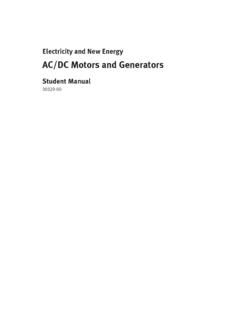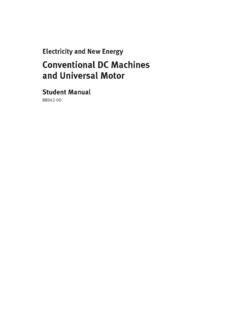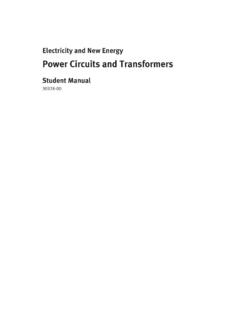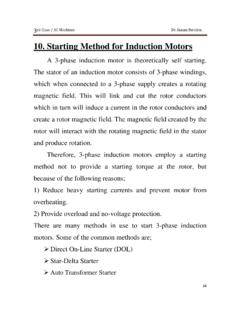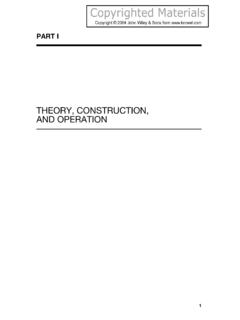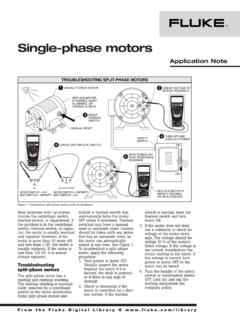Transcription of Single-Phase Induction Motors - LVSIM-EMS
1 Electricity and New Energy Single-Phase Induction Motors Student Manual 88944-00 Order no.: 88944-00 First Edition Revision level: 11/2014 By the staff of Festo Didactic Festo Didactic Lt e/Ltd, Quebec, Canada 2013, 2014 Internet: e-mail: Printed in Canada All rights reserved ISBN 978-2-89640-628-9 (Printed version) ISBN 978-2-89640-629-6 (CD-ROM) Legal Deposit Biblioth que et Archives nationales du Qu bec, 2014 Legal Deposit Library and Archives Canada, 2014 The purchaser shall receive a single right of use which is non-exclusive, non-time-limited and limited geographically to use at the purchaser's site/location as follows. The purchaser shall be entitled to use the work to train his/her staff at the purchaser's site/location and shall also be entitled to use parts of the copyright material as the basis for the production of his/her own training documentation for the training of his/her staff at the purchaser's site/location with acknowledgement of source and to make copies for this purpose.
2 In the case of schools/technical colleges, training centers, and universities, the right of use shall also include use by school and college students and trainees at the purchaser's site/location for teaching purposes. The right of use shall in all cases exclude the right to publish the copyright material or to make this available for use on intranet, Internet and LMS platforms and databases such as Moodle, which allow access by a wide variety of users, including those outside of the purchaser's site/location. Entitlement to other rights relating to reproductions, copies, adaptations, translations, microfilming and transfer to and storage and processing in electronic systems, no matter whether in whole or in part, shall require the prior consent of Festo Didactic GmbH & Co. KG. Information in this document is subject to change without notice and does not represent a commitment on the part of Festo Didactic. The Festo materials described in this document are furnished under a license agreement or a nondisclosure agreement.
3 Festo Didactic recognizes product names as trademarks or registered trademarks of their respective holders. All other trademarks are the property of their respective owners. Other trademarks and trade names may be used in this document to refer to either the entity claiming the marks and names or their products. Festo Didactic disclaims any proprietary interest in trademarks and trade names other than its own. Festo Didactic 88944-00 III Safety and Common Symbols The following safety and common symbols may be used in this manual and on the equipment: Symbol Description DANGER indicates a hazard with a high level of risk which, if not avoided, will result in death or serious injury. WARNING indicates a hazard with a medium level of risk which, if not avoided, could result in death or serious injury. CAUTION indicates a hazard with a low level of risk which, if not avoided, could result in minor or moderate injury.
4 CAUTION used without the Caution, risk of danger sign , indicates a hazard with a potentially hazardous situation which, if not avoided, may result in property damage. Caution, risk of electric shock Caution, hot surface Caution, risk of danger Caution, lifting hazard Caution, hand entanglement hazard Notice, non-ionizing radiation Direct current Alternating current Both direct and alternating current Three-phase alternating current Earth (ground) terminal Safety and Common Symbols IV Festo Didactic 88944-00 Symbol Description Protective conductor terminal Frame or chassis terminal Equipotentiality On (supply) Off (supply) Equipment protected throughout by double insulation or reinforced insulation In position of a bi-stable push control Out position of a bi-stable push control Festo Didactic 88944-00 V Table of Contents Preface .. VII About This Manual .. IX Introduction AC Induction Motors .. 1 DISCUSSION OF FUNDAMENTALS.
5 1 Introduction to ac Induction Motors .. 1 Exercise 1 Operation and Characteristics of Single-Phase Induction Motors .. 5 DISCUSSION .. 5 Simple Single-Phase squirrel-cage Induction motor .. 5 Adding a capacitor and an auxiliary winding to the Single-Phase Induction motor .. 7 Centrifugal switch .. 9 PROCEDURE .. 10 Set up and connections .. 10 Three-phase, two-phase, and Single-Phase operation of a three-phase squirrel-cage Induction motor .. 11 Operation of a Single-Phase Induction motor (split-phase and capacitor-start types) .. 14 Appendix A Equipment Utilization Chart .. 21 Appendix B Glossary of New Terms .. 23 Appendix C Circuit Diagram Symbols .. 25 Index of New Terms .. 31 Bibliography .. 33 Festo Didactic 88944-00 VII Preface The production of energy using renewable natural resources such as wind, sunlight, rain, tides, geothermal heat, etc., has gained much importance in recent years as it is an effective means of reducing greenhouse gas (GHG) emissions.
6 The need for innovative technologies to make the grid smarter has recently emerged as a major trend, as the increase in electrical power demand observed worldwide makes it harder for the actual grid in many countries to keep up with demand. Furthermore, electric vehicles (from bicycles to cars) are developed and marketed with more and more success in many countries all over the world. To answer the increasingly diversified needs for training in the wide field of electrical energy, the Electric Power Technology Training Program was developed as a modular study program for technical institutes, colleges, and universities. The program is shown below as a flow chart, with each box in the flow chart representing a course. The Electric Power Technology Training Program. Preface VIII Festo Didactic 88944-00 The program starts with a variety of courses providing in-depth coverage of basic topics related to the field of electrical energy such as ac and dc power circuits, power transformers, rotating machines, ac power transmission lines, and power electronics.
7 The program then builds on the knowledge gained by the student through these basic courses to provide training in more advanced subjects such as home energy production from renewable resources (wind and sunlight), large-scale electricity production from hydropower, large-scale electricity production from wind power (doubly-fed Induction generator [DFIG], synchronous generator, and asynchronous generator technologies), smart-grid technologies (SVC, STATCOM, HVDC transmission, etc.), storage of electrical energy in batteries, and drive systems for small electric vehicles and cars. Do you have suggestions or criticism regarding this manual? If so, send us an e-mail at The authors and Festo Didactic look forward to your comments. Festo Didactic 88944-00 IX About This Manual The present manual, Single-Phase Induction Motors , introduces the student to the operation and characteristics of the following two types of Single-Phase Induction motor : capacitor-start Induction motor and split-phase Induction motor .
8 These Motors , although still in use in numerous applications today, are less common in modern applications where they are often replaced with three-phase Induction motor drives ( , a three-phase squirrel-cage Induction motor plus a variable-frequency, three-phase inverter) for added flexibility of operation and improved performance. Safety considerations Safety symbols that may be used in this manual and on the equipment are listed in the Safety Symbols table at the beginning of the manual. Safety procedures related to the tasks that you will be asked to perform are indicated in each exercise. Make sure that you are wearing appropriate protective equipment when performing the tasks. You should never perform a task if you have any reason to think that a manipulation could be dangerous for you or your teammates. Prerequisite As a prerequisite to this course, you should have read the manuals titled DC Power Circuits, part number 86350 and Single-Phase AC power Circuits, part number 86358.
9 Systems of units Units are expressed using the International System of Units (SI) followed by the units expressed in the customary system of units (between parentheses). Festo Didactic 88944-00 1 When you have completed this manual, you will be able to demonstrate the main operating characteristics of Single-Phase Induction Motors . The Discussion of Fundamentals covers the following points: Introduction to ac Induction Motors Introduction to ac Induction Motors According to Faraday's law of electromagnetic Induction , a voltage is induced between the ends of a wire loop when the magnetic flux passing through the loop varies as a function of time. If the ends of the wire loop are short-circuited together, a current flows in the loop. Figure 2 shows a magnet that is displaced rapidly toward the right above a group of conductors. The conductors are short-circuited at their extremities by bars A and B and form a structure similar to a ladder.
10 Figure 2. Magnet moving above a conducting ladder. Current flows in the loop formed by conductors 1 and 2, as well as in the loop formed by conductors 2 and 3. These currents create magnetic fields having north and south poles, as Figure 3 shows. AC Induction Motors Introduction MANUAL OBJECTIVE DISCUSSION OUTLINE DISCUSSION OF FUNDAMENTALS Figure 1. The principles behind the operation of alternating-current Motors are usually credited to scientist Nikola Tesla. Magnet movement N S 1 2 3 Bar A Bar B Introduction AC Induction Motors Discussion of Fundamentals 2 Festo Didactic 88944-00 Figure 3. Current in the conductors creates magnetic fields. The interaction between the magnetic field of the magnet and the magnetic fields produced by the currents induced in the ladder creates a force between the moving magnet and the ladder.

